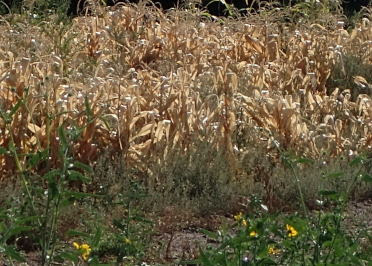On my way back from the Barrancos I followed the path left by water. This was less a point of curiosity than the easiest way to negotiate broken land. The rivulet began somewhere in the hillocks below the fan before the cliffs.
From there the water wound through low hills.
The water reached more gently sloping ground, where its path was marked by the lack of vegetation. Once in a while, the bottoms was littered with gravel it had recently picked up, but mainly it was a slightly shinier, more level continuation of the banks.
When it reached a more level area where sedimentary gravel covered the ground, it spread wider. Juniper trees grew along both sides.
Below the junipers softer soils appeared. The line was crossed between Tertiary and modern alluvium. Water was no longer able to define a specific course. It spread into a flood plain, leaving areas bare of vegetation. The only clues for where water had flowed were gravel deposits.
The water was flowing generally northeast toward the arroyo when it collided with an ATV trail headed straight for the north end of the cliffs. The water ricocheted back. It was lower than the trail.
From there it ran parallel to the ATV track, preternaturally straight. Its depth varied with soil. When it found something soft, it was deep. One time it was deep, a wash was opening on the other side of the track. At another the banks were caked with grey mud.
When a particular grass was resistant, it disappeared in the shadows.
When it encountered another channel coming from the southwest, it got lost in another flood plain, until the channel reformed next to the ATV track.
The pattern repeated itself: a straight run, a collision with another water stream, a confused path, rationalization along side the higher road.
Then, a competing channel came through at just a point in the descent where the ATV track was nearly level with my water path. The abutting channel swept across the track, pulling my stream in its wake.
An arroyo feeder formed in the softer soils, twisting and turning around small changes in the earth. Sometimes, one side was steep and the other a delta; it other places the sides were the same. It behaved again like one would expect water to behave.
Just before it reached the arroyo there was a small washout, perhaps formed when water was backup during a storm by stronger currents in the far arroyo.
The feeder entered the arroyo downstream from where the ATV track began. The water dropped its final load of stones as it changed course when it met the waters in the arroyo. From there it flowed towards the Rio Grande.



















































